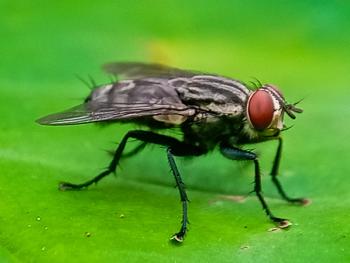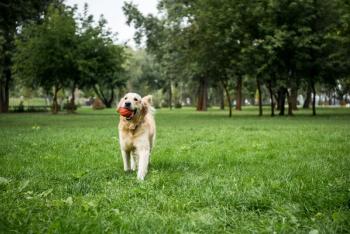
Deworming: Next steps in disease prevention
West LaFayette, Ind. - Following an aggressive deworming schedule for dogs and cats could have a significant impact on the zoonotic transmission of parasitic diseases, according to one expert.
West LaFayette, Ind. — Following an aggressive deworming schedule for dogs and cats could have a significant impact on the zoonotic transmission of parasitic diseases, according to one expert.
"The focus in the last few years has been on more regular deworming, monthly and year-round," says Kevin R. Kazacos, DVM, PhD, professor of veterinary parasitology and director of the Clinical Parasitology Laboratory at the Purdue University School of Veterinary Medicine in West Lafayette, Ind. Kazacos is past president of the Companion Animal Parasite Council (CAPC).
The increasing presence of animals as part of the family unit brings more opportunities for transmission of disease from animals to humans. Although there has been a strong public focus on the dangers and prevention of heartworms in animals, intestinal parasites such as roundworms (Toxocara canis and T. cati), raccoon roundworms (Baylisascaris procyonis) and hookworms (Ancylostoma spp.) are, in many cases, more common and may be transmitted directly to humans.
The CAPC recommends:
Because puppies and kittens are especially vulnerable to such infections, their popularity means children can be at the most risk for zoonotic transmission. Recent studies document a national seroprevalence of dog and cat ascarid larvae in children of 14 percent, and it approaches 28 percent in some areas of the United States and Canada.
"We see human cases in this country all the time," Kazacos says. "These are more common than people realize, but they are not reportable diseases so they're hard to track. But it doesn't mean that they don't occur."
Toxocara in animals and humans
Toxocara (roundworm) infections are common in animals throughout the world, with some studies showing that over 30 percent of dogs younger than 6 months in the United States shed eggs in their feces. Infections in dogs and cats result from the ingestion of eggs from fecal contaminated environments, transmission of larvae to the fetal or young animal via transplacental or transmammary routes or ingestion of larvae contained in the tissues of other animals. Infected animals may present with potbellies, poor coat, GI signs and a failure to thrive. Severe infections in very young animals may even be fatal.
Zoonotic transmission of roundworms to humans is well-documented and, by no means, rare. It is estimated that up to six million people are infected each year with Toxocara larva migrans (Schantz, PM. Toxocara larva migrans now. Am J Trop Med Hyg 1989;41(Suppl):21.). Especially at risk are children whose activities bring them into contact with dirt or other areas that may be contaminated with eggs from the stool of infected animals. High prevalences of toxocariasis have been documented both in rural and urban environments, wherever animals roam freely and/or regular deworming schedules are not instituted or maintained.
In humans, larval infections can be located in the eye (ocular larva migrans, or OLM) resulting in permanent vision loss; in the viscera (visceral larva migrans, or VLM) where damage and inflammation are located in the liver, lungs and other organs; or in the nervous system (neural larva migrans, or NLM), causing clinical neurologic disease. Young children with heavy infection are at the greatest risk of developing VLM, with liver swelling and inflammation, respiratory disease from lung migration and high, persistent eosinophilia. However, many cases are mild or subclinical (covert infection), related to lower levels of infection and the presence of nonspecific clinical signs.
Baylisascaris infections
Like Toxocara, Baylisascaris (raccoon roundworm) is acquired through ingestion of eggs shed in the feces of infected animals — in this case raccoons and, occasionally, dogs. This parasite has been found in raccoons throughout the United States, and some studies show that more than 90 percent of raccoons in defined geographic areas are infected. In North America, encephalitis from Baylisascaris infection (NLM) has killed more than 120 species of animals, and the presence of this parasite in dogs means that its transmission to humans may be more easily accomplished.
Because of their larger size and aggressive migration, Baylisascaris larva migrans causes significant symptoms in both animals and humans, especially in the ocular or neural forms of the disease. Blindness, liver enlargement, neurologic symptoms and high eosinophilia all have been documented. In children, Baylisascaris infection can result in severe eosinophilic encephalitis and subsequent neurologic disability. Unless a correct diagnosis is made early and aggressive treatment instituted, Baylisascaris infections can be fatal.
Hookworms
Ancylostoma (hookworms) are common parasites in animals throughout the United States; recent studies have documented the presence of Ancylostoma eggs in the feces of up to 20 percent of tested dogs and cats. Animals become infected by ingesting larvae, by larval penetration of the skin or, in the case of nursing puppies, via transmammary transmission. Hookworms suck blood from their hosts, leading to severe anemia, dehydration, respiratory disease, diarrhea, tarry stools and failure to thrive. Heavy infections with hookworms in puppies and kittens may be fatal.
Zoonotic transmission of hookworms takes place primarily by penetration of the larvae through the skin. Hookworms are the main cause of cutaneous larva migrans (CLM) in humans, resulting in an eruptive migrating dermatitis along the paths of penetration and migration. The primary cause of CLM in humans is the dog and cat hookworm, A. braziliense, found in warm regions such as the Gulf coast, Florida and the Caribbean. Larvae of the common dog hookworm, A. caninum, can migrate to the intestine of humans, where they develop to young adults and produce eosinophilic enteritis. As with ascarids, children are especially prone to these infections because of activities that bring them into contact with contaminated soil, but any humans who are in regular contact with moist soil can be easily infected.
Step up deworming
The main plank of the CAPC guidelines, Kazacos says, builds on Center for Disease Control (CDC) recommendations aimed at decreasing the transmission of zoonotic roundworms and hookworms to children.
"The former deworming standards of once or twice per year for dogs did little for parasite control, and cats weren't necessarily dewormed at all," Kazacos tells DVM Newsmagazine. "Ten years ago that recommendation was increased to three to four times per year for dogs, but we can see now that even that hasn't been enough."
CAPC recommends that, whenever possible, puppies and kittens be dewormed initially at 2 and 3 weeks of age, respectively, with repeated dewormings every two weeks until 8 and 9 weeks of age. At the appropriate age all puppies and kittens should be started on monthly heartworm preventatives that demonstrate activity against roundworms and hookworms. In addition, stool samples should be checked several times during the animal's first year to document the effectiveness of treatment, and once or twice per year thereafter to monitor effectiveness of the regimen as well as owner compliance. Modifications to this routine can be made based on the particular animal and its lifestyle.
This shift in emphasis from heartworm prevention to monthly broad- spectrum parasite control is gaining acceptance by most veterinarians, even in areas where heartworm is less of a problem.
"If we can control the GI worms by regular use of these products, heartworms will also be prevented as part of the program," Kazacos says.
Other responsibilities
Kazacos encourages veterinarians to take a more aggressive role when it comes to diagnosing, preventing and controlling parasitic diseases. In addition to treating animals for these infections, the importance of regular fecal clean-up should be stressed as part of overall control. This should be applied to both the pet in its own environment as well as to those with access to public areas, such as parks and playgrounds.
Because of the virulent nature of Baylisascaris infections, Kazacos notes: "Veterinarians have a responsibility to spread the word about these parasites; keep children away from contaminated areas, and discourage keeping raccoons or skunks as pets."
"These diseases are preventable," Kazacos adds. "We need to take zoonotic parasites more seriously as a profession and do a better job of controlling them. If we can get pet owners in all areas to deworm year-round, then our profession will have the greatest impact in preventing human disease due to these parasites."
For further information go to http://
Wetzel is a freelance writer in Cleveland, Ohio
Newsletter
From exam room tips to practice management insights, get trusted veterinary news delivered straight to your inbox—subscribe to dvm360.





